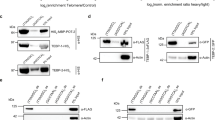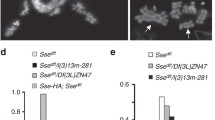Abstract
In this paper we describe the isolation and characterization of rTP, thereplicationTelomereProtein, formerly known as the telomere protein homolog. The rTP was initially identified because of its homology to the gene for theOxytricha telomere-binding protein α-subunit. The protein encoded by the rTP gene has extensive amino acid sequence identity to the DNA-binding domain of the telomere-binding proteins from bothEuplotes crassus andOxytricha nova. We have now identified the protein encoded by the rTP gene and have shown that it differs from the telomere-binding protein in its abundance, solubility and intracellular location. To learn more about the function of rTP, we determined when during theEuplotes life cycle the gene is transcribed. The transcript was detectable only in nonstarved vegetative cells and during the final stages of macronuclear development. Since the peak transcript level coincided with the rounds of replication that take place toward the end of macronuclear development, it appeared that rTP might be involved in DNA replication. Immunolocalization experiments provided support for this hypothesis as antibodies to rTP specifically stain the replication bands. Replication bands are the sites of DNA replication inEuplotes macronuclei. Our results suggest that rTP may be a new telomere replication factor.
Similar content being viewed by others
References
Ausubel FM, Brent R, Kingston RE, Moore, DD, Seidman JG, Smity JA, Struh K (eds) (1988) Current protocols in molecular biology, unit 42, Section 4.2. Wiley, New York
Biessmann H, Mason JM (1992) Genetics and molecular biology of telomeres. Annu Rev Genet 30: 185–249
Blackburn E (1991) Telomeres, TIBS 16: 378–381
Blackburn E, Greider C (eds) (1995) Telomeres, Cold Spring Harbor Laboratory Press, Cold Spring Harbor, NY
Brown WC, Campbell JL (1993) Interaction of proliferating cell nuclear antigen with yeast DNA polymerase delta. J Biol Chem 268: 21706–21710
Burgers PMJ (1989) Eukaryotic DNA polymerase α&γ: Conserved properties from yeast to mammalian cells. Prog Nucleic Acids Res Mol Biol 37: 235–282
Collins K, Kobayashi R, Greider CW (1995) Purification ofTetrahymena telomerase and cloning of genes encoding the two protein components of the enzyme. Cell 81: 677–686
Fang G, Cech TR (1995a) Telomerase RNA localized in the replication band and spherical subnuclear organelles in hypotrichous ciliates. J Cell Biol 130: 243–253
Fang G, Cech TR (1995b) Telomere proteins. In: Blackburn E, Greider C (eds), Telomeres. Cold Spring Harbor Laboratory Press, Cold Spring Harbor, NY, pp 69–105
Fang G, Gray JT, Cech TR (1993)Oxytricha telomere-binding protein: separable DNA-binding and dimerisation domains of the alpha subunit. Genes Dev 7: 870–882
Garvik B, Carson M, Hartwell L (1995) Single-stranded DNA arising at telomeres in cdc 13 mutants may constitute a specific signal for the RAD9 checkpoint. Mol Cell Biol 15: 6128–6138
Gottschling DE, Zakian VA (1986) Telomere proteins: specific recognition and protection of the natural termini ofOxytricha macronuclear DNA. Cell 47: 195–205
Gray JT, Celander DW, Price CM, Cech TR (1991) Cloning and expression of genes for theOxytricha telomere-binding protein: specific subunit interactions in the telomeric complex. Cell 67: 807–814
Hicke BJ, Willis MC, Koch TH, Cech TR (1994) Telomeric protein-DNA point contacts identified by photo-cross-linking using 5-bromodeoxyuridine. Biochemistry 33: 3364–3373
Klobutcher LA, Prescott DM (1986) The special case of the hypotrichs. In: Gall JG (ed.), Molecular biology of ciliated protozoa. Academic Press, New York, pp 111–154
Klobutcher LA, Swanton MT, Donini P, Prescott DM (1981) All gene-sized DNA molecules in four species of hypotrichs have the same terminal sequence and an unusual 3′ terminus. Proc Natl Acad Sci USA 78: 3015–3019
Linger J, Cooper JP, Cech TR (1995) Telomerase and DNA end replication: no longer a lagging strand problem? Science 269: 1533–1534
Lundblad V, Szostak JW (1989) A mutant with a defect in telomere elongation leads to senescence in yeast. Cell 57: 633–643
Murti KG, Prescott DM (1983) Replication forms of the genesized DNA molecules of hypotrichous ciliates. Mol Cell Biol 3: 1562–1566
Olins DE, Olins AL (1994) The replication band of ciliated protozoa. Int Rev Cytol 153: 137–170
Olins D, Olins A, Cacheiro L, Tan E (1989) Proliferation cell nuclear antigen/cyclin in the ciliateEuplotes eurystomus: localization in the replication band and in the micronuclei. J Cell Biol 109: 1399–1410
Prelich G, Tan C-K, Kostura M, Mathews MB, So AG, Downey KM, Stillman B (1987) Functional identity of proliferating cell nuclear antigen and a DNA polymerase-delta auxiliary protein. Nature 326: 517–520
Prescott DM (1994) The DNA of ciliated protozoa. Microbial Rev 58: 233–267
Price CM (1990) Telomere structure inEuplotes crassus: characterization of DNA-protein interactions and isolation of a telomere-binding protein. Mol Cell Biol 10: 3421–3431
Price CM (1995) Telomere-binding proteins of ciliated protozoa. Nucleic Acids Mol Biol 9: 299–307
Price CM, Adams AK, Vermeesch JR (1994) Accumulation of telomerase RNA and telomere protein transcripts during telomere synthesis inEuplotes. J Eukaryotic Microbiol 41: 267–275
Price CM, Cech TR (1989) Properties of the telomeric DNA-binding protein fromOxytricha nova. Biochemistry 28: 769–774
Price C, Skopp R, Krueger J, Williams D (1992) DNA recognition and binding by theEuplotes telomere protein. Biochemistry 31: 10835–10843
Prussak CE, Almazan MT, Tseng BY (1989) Mouse primase p49 subunit molecular cloning indicates conserved and divergent regions. J Biol Chem 9: 4957–4963
Roth M, Prescott DM (1985) DNA intermediates and telomere addition during genome reorganization inEuplotes crassus. Cell 41: 411–417
Studier WF, Rosenberg AH, Dunn JJ, Dubendorff JW (1990) Use of T7 RNA polymerase to direct expression of cloned genes. Methods Enzymol 185: 60–89
Vermeesch JR, Price CM (1994) Telomeric DNA sequence and structure following de novo telomere synthesis inEuplotes crassus. Mol Cell Biol 14: 554–566
Vermeesch JR, Williams D, Price CM (1993) Telomere processing inEuplotes. Nucleic Acids Res 21: 5366–5371
Wang W-L (1994) Telomere protein and telomere protein homolog inEuplotes crassus. PhD thesis. University of Nebraska, Lincoln
Wang W-L, Skopp R, Scofield M, Price C (1992)Euplotes crassus has genes encoding telomere-binding proteins and telomere-binding protein homologs. Nucleic Acids Res 20: 6621–6629
Zahler AM, Prescott DM (1989) DNA primase and the replication of the telomeres inOxytricha nova. Nucleic Acids Res 17: 6299–6317
Zuber M, Tan EM, Ryoiu M (1989) Involvement of proliferating cell nuclear antigen (cyclin) in DNA replication in living cells. Mol Cell Biol 9: 57–66
Author information
Authors and Affiliations
Corresponding author
Additional information
Edited by: V. Zakian
Rights and permissions
About this article
Cite this article
Skopp, R., Wang, W. & Price, C. rTP: a candidate telomere protein that is associated with DNA replication. Chromosoma 105, 82–91 (1996). https://doi.org/10.1007/BF02509517
Received:
Revised:
Accepted:
Issue Date:
DOI: https://doi.org/10.1007/BF02509517




